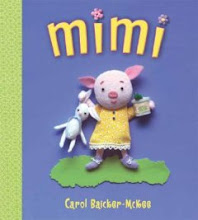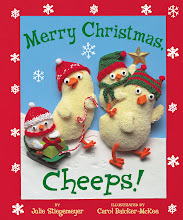 |
| Koko Acrylic Painting by Sara Baicker-McKee |
I was never a dog person.
Except for a neurotic collie that my parents gave away when we moved from California to Virginia when I was a year old, my family always had cats, not dogs. Thanks to Diddle, Mittens, Lucy, and Jelly Bean, to this day, I am sucker for purring, sandpaper tongues, and the way a cat rubs against your legs. (Okay, this is completely off topic, but that reminded me. Let's say you're working on an illustration and you need a photo reference of a "kitten rubbing against someone's leg" - let me give you a tip. Do NOT do an internet search for that phrase. The images that come up do not bear much resemblance to young felines.)
Anyway, I always figured I'd have a cat someday, but when my oldest son turned out to be allergic, we opted instead for a series of little caged critters: mice, a hamster, a guinea pig, a chinchilla, a whole mess of roly poly bugs.
 |
| Mini-beaded Koko. By Sara, age 10 or so. |
Life was good, right? Only not for my youngest, my daughter Sara. Almost from the moment she was born, she had A Thing for dogs. As a tiny infant, her eyes widened and her whole body quivered whenever she spied a dog. "Woof" was one of her first words. By the time she was a preschooler, she preferred her cousins' threadbare hand-me-down doggy costume to even the sparkliest princess getup, knew the distinguishing characteristics of dozens of dog breeds, and she and her best buddy got in trouble at preschool for only speaking in dog and preferring to consume their graham crackers and milk doggy- style. (By that I mean no hands! And don't do an internet search for that term either!) When Christmas and her birthday rolled around, every year Sara's wish list contained just one item: a real, live dog. If she couldn't have that, then nothing, thank you.
Despite this pressure, I did a pretty good job of remaining canine-free. I had three closely-spaced kids, a menagerie of critters in cages, and the occasional uncaged "visitor." Plenty of mess and noise and walks and poop to deal with already. And despite the promises of my daughter and other family members, I knew who would end up taking care of any dog that entered the household.
 |
| Puppy Koko. By Sara at age 8 |
Then I made a deadly error. For the first time since my kids were born, I went away by myself on a just-for-fun girls weekend.
And came home to find myself a dog owner. Well, a dog-owner to be, since the puppies were too young to leave their mother.
For the twelve years since then, as predicted, I've had even more mess and noise and walks and poop to deal with. And yes, I've been the primary caregiver for Koko.
And I've loved it. Koko captured my heart from the moment she entered our house, a round-bellied, wrinkle-faced pug puppy who charmed us by wearing an old sock with holes cut out for her head and legs, wrestling Big Kitty, the huge stuffed animal sent home with her, and chewing everyone's shoelaces to shreds.
For the first few months, we regularly debated who was smarter, Koko or a post, and the post usually won. But over time, thanks to being very strongly motivated by any remotely food-like substance, she has proved herself to be a fair bit sharper than the post. She easily learned the usual tricks like "Sit!" and "Stay!" and "Roll Over!" and "Bang! You're dead." But she also learned trickier tricks, like how to balance a cheerio on her nose and wait a long time until you say "okay!" to toss it in the air and catch it neatly in her mouth, and how to jump through a hula hoop like a circus dog (though no longer so high as she used to), and, perhaps trickiest of all, how to walk around a treat just lying there on the floor ripe for the gobbling when ordered to "leave it!" Plus she learned the commands in French, as well as English. Pretty good, huh?
 |
| Miniature Koko in polymer clay, by Sara around age 10. |
Perversely, for twelve years, she has refused to learn the command "Come!" - but breaks land-speed records to be at your side if you even spell the word "treat." (For that matter, she recognizes several dozen spelled words, for some reason, all food-related...). She even figured out how to shove a chair around the kitchen to get on the table or counter if someone foolishly left food up high, only giving up the practice once arthritis got the better of her joints.
 |
| Koko. Illustration in cut paper, polymer clay and wood by me (Carol Baicker-McKee) from unsold picture book, Little Dog |
But somehow, none of that matters to me, the cat-lover. (Though it all drives my husband, a lifelong dog guy himself, absolutely batty. Go figure.)
We celebrated her birthday this year with a tea party by the fire. Nice and cozy for all our aging bones.
The visiting cat was invited but declined.
She had some work to get done on the computer.
And then she needed to wash her hair.
I'll polish off the celebration with a few of our favorite children's books featuring pugs (though of course, none is as cute as Koko - who even made this week's "Pets on Furniture" feature by Kim on the addicting design blog Desire to Inspire).
 |
| Eloise and Weenie by Hilary Knight for Kay Thompson's Eloise |
Say Hello to Zorro by Carter Goodrich is a relatively new book (2011) and is as suitable for families welcoming a new child as it is for pug lovers or dog lovers in general. Mister Bud has his life all figured out - until the usurper pug Zorro shows up and wrecks everything. (Fortunately it all works out. Phew.) Goodrich does a great job of capturing the big-dog temperament of pugs, as well as their stocky physique and no-nonsense expressions. Love!
Jennifer Sattler's Chick 'n' Pug is another relatively recent title (2010) and tells a tale of mistaken impressions. Chick, having read books about a superhero pug is ripe for disappointment when she finally meets a real live pug - who is more like the typical couch potato of the breed. But again, all works out!
For older readers, I recommend the Molly Moon books by Georgia Byng, beginning with Molly Moon's Book of Hypnotism. Molly is a quick-witted orphan, and the pug is, uh, the bad-tempered sidekick of the villain - but it's all lots of fun for middle-grade readers.
One final note: my dog-loving daughter Sara is all grown up now and paints wonderfully sensitive dog portraits like the one that opens this post in her smidge of free time. If you're interested in a portrait of a beloved pet, you can contact her here through me. Just shoot me an email at baickermckee[at]gmail[dot]com or leave a comment here with info on how to contact you.



















































